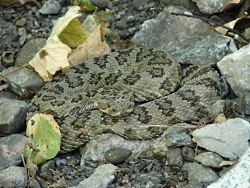
Courtesy & Copyright © 2009 Holly Strand
Rattlesnakes are pit vipers with heavy bodies and broad heads. There are about 30 species and 40 more subspecies found in North and South America. They aren’t found anywhere else. All possess rattles and all are venomous.
Here in Utah we have 5 species plus 2 subspecies. The Great basin rattlesnake is the most widespread, living all across Western Utah at elevations up to 9000 feet. Another subspecies of western rattler–the midget faded rattlesnake –is dominant in the eastern part of the state. The Hopi rattlesnake and the greenish colored prairie rattlesnake are found in southeastern Utah. And the Mojave rattlesnake, speckled rattlesnake, and sidewinder are found only in the extreme southwest corner of Utah.
The rattle itself is a unique biological feature. It’s a loose, but interlocking series of nested segments—actually modified scales– at the end of the tail. When vibrated, the rattle produces a hissing sound. Kevin Colver– an expert in natural sound recordings –provided this clip of a Mojave rattlesnake.
A snake gets a new rattle segment every time it sheds—and it sheds from one to four times a year. 15 or 16 rattles are common in captive snakes, but in wild snakes six to eight are more common. In wild snakes, rattles are subject to a lot of wear and tear. So they break off before they get very long.
The rattle sound is the reaction of a startled or threatened snake. You’ll often see the rattling snake in a defensive S-shaped coil—but not always!
Aggression and venom in rattlesnakes vary by both species type and by individual. The western diamondback rattlesnake is the archetypal large, aggressive and very dangerous species, responsible for the majority of human fatalities in America. But it’s northern range limit is south of the Utah border. However, the Mojave rattler found in southeastern Utah is extremely toxic, excitable and its venom attacks both the nervous system and circulatory system.
But rattlesnakes aren’t out to get us—mainly they just want to be left alone. You’ll generally be fine if you stay aware of what might be in or around rocks, and don’t walk barefoot or in open-toed shoes in their habitat. Also, use a flashlight after dark –most rattlesnakes are active at night too!
Thanks to the Rocky Mountain Power Foundation for supporting the development of this Wild About Utah topic.
And to Kevin Colver for the sound of the rattlesnake. Additional nature sound recordings can be found at westernsoundscape.org
For Wild About Utah and Stokes Nature Center, I’m Holly Strand.
Credits:
Sound: Courtesy and Copyright 2006 Kevin Colver
Image: Courtesy and Copyright 2009 Holly Strand
Text: Holly Strand, Stokes Nature Center
Sources & Additional Reading
Klauber, Laurence M. 1982. Rattlesnakes. Their Habits, Life Histories, and Influence on Mankind. Berkeley: University of California Press, https://www.amazon.com/Rattlesnakes-Habits-Histories-Influence-Mankind/dp/0520210565 (1997 Version)
Utah Division of Wildlife Resources. Utah Conservation Data Center. https://dwrcdc.nr.utah.gov/ucdc/ (Accessed July 17, 2009)
